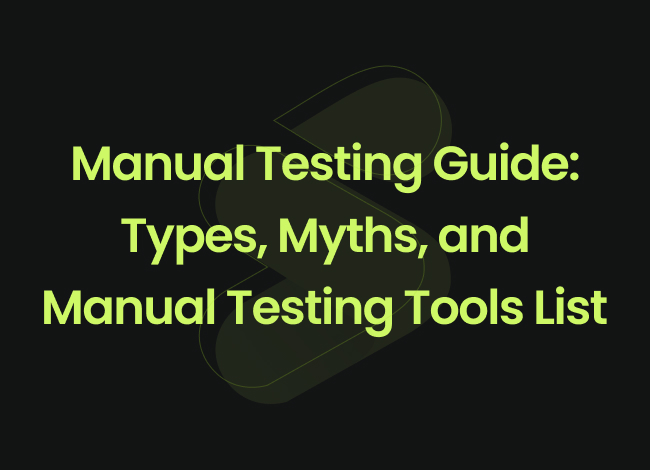Introduction
Manual testing is an essential form of testing, where we manually test digital products with our own hands. This testing comes with a lot of benefits and is widely adopted by testers for their daily tasks. In this manual testing guide, we will clearly explain different types of manual testing, related manual testing myths, and a brief list of tools. So just stay with me and get ready to boost your knowledge about manual testing.
What is Manual Testing?

In this manual testing guide, the first thing that needs to be discussed is manual testing. So in simple words, it can be said that when it comes to testing, there are two approaches that one can adopt. Either the tests and test cases can be executed with the help of tools, or by hand manually. The later procedure or technique is called manual testing. So in short, manual testing is the testing of a product by hand manually. There are several types of manual testing which we will address in the later part of the blog.
Manual Testing and its Different Types
When it comes to manual testing, there are several types of manual testing that you can deploy for testing your product. Each type of testing helps you test a different feature of your digital product. Following are some of the very famous types of manual testing:
Functional Testing
In our manual testing guide, the first type of manual testing to discuss is functional testing. Functional testing checks if the software does what it’s supposed to do. It focuses on making sure every feature works as expected. This type of testing looks at the basic actions and outcomes.
Usability Testing
The next type in our manual testing guide is usability testing. Usability testing is all about making sure the software is easy to use. Testers see if people can use it without confusion. The goal is to make the experience smooth and simple.
Regression Testing
Regression testing checks that changes made to the software haven’t caused any problems. It ensures that new updates or fixes don’t break anything that was working before.
Smoke Testing
Smoke testing quickly checks if the basic parts of the software work. It’s like a quick health check for the software. If the main features are working, then testing can continue. This is a very important type to be discussed in our blog about manual testing myths.
Exploratory Testing
Exploratory testing is when testers use their creativity to find issues. They explore the software without a strict plan. This type of testing can uncover unexpected problems. Exploratory testing stands out among all types in our blog of manual testing myths.
Acceptance Testing
The last one among the manual testing types is acceptance testing. Acceptance testing is the final check to see if the software is ready to be used. It ensures the software meets the needs and expectations of the users before it’s released.
Common Myths About Manual Testing
After discussing the manual testing types, now it’s time we shed some light on one of the most important parts of our blog i.e. myths. Manual testing is a very popular testing approach and there are several manual testing techniques and associated myths. Following are some of the famous myths about manual testing:
Manual Testing is Very Easy
The very first manual testing myth busted is that this testing is super easy. People think that every other person who knows about computers and is interested in the field can conduct this testing and get the desired results. However, this is just one of the manual testing myths busted. This testing is not as simple as it seems. To conduct it, a person requires sound knowledge and he must be extremely detail-oriented, obsessed with product quality, think extraordinary, know different software development aspects, and many others.
It’s Old and Outdated
The next myth associated with manual testing types is that it is quite old and outdated and soon there are chances of it being replaced by automated testing. This is a very famous myth but still, it’s just a myth and the reality is quite opposite to it. Automation can never replace the manual testing process because it is a basic process that helps to create a stable product. only after that, the automation testing can be initiated. Hence manual testing process is neither outdated nor can be replaced by automated testing.
It takes Too Much Time
The next associated myth is that this testing is slow and can take a lot of time to give the desired results. But this is also just a myth about manual testing tools and processes because through ad hoc scenarios, exploratory testing, and usability testing, manual testing can quickly identify serious problems that automated tests might miss. Besides it, manual testing not only takes less time, but also it is quite flexible and adaptable to changing requirements.
Manual Testing Can Have Human Errors Involved
The next myth about the best manual testing tools and procedures is that just because there is human involvement in the testing, there is always a chance of errors in the process and even in the results. This myth can be clarified with the answer that with proper processes and advanced manual testing techniques, the chances of errors can be greatly reduced. Due diligence, experience, and using the best manual testing tools can help find and fix errors, resulting in greater software quality.
Manual Testing Tools
Now comes the next part of our blog where we will discuss a manual testing tools list. This list includes some very famous tools of manual testing that are quite famous in the market due to their quality and cheap prices. Following is a detailed manual testing tools list:
Selenium
The first tool that can provide outstanding manual testing advantages is Selenium. It is a popular choice for web application testing. It allows testers to automate web browsers across different platforms. It’s versatile, supporting multiple browsers and programming languages, which makes it a go-to tool for many testers.
JIRA
The next tool that can ensure manual testing advantages is JIRA. This is widely used for project management and bug tracking. It helps teams organize their work by tracking issues, bugs, and tasks. Its integration capabilities and customizable workflows make it a strong tool for managing manual testing projects.
TestRail
TestRail is one of the best manual testing tools for beginners. It is a reliable test management tool designed to help teams manage and organize their testing efforts. It provides detailed reports and insights into test case progress. The tool integrates smoothly with other tools like JIRA, making it easier to keep track of testing activities.
qTest
qTest is known for its robust test management features. It allows testers to create, manage, and execute test cases with ease. The tool offers real-time reporting and collaboration features, which are especially useful for teams working on large projects. This is one of the most affordable manual testing tools for beginners.
Bugzilla
An open-source program called Bugzilla facilitates effective bug tracking and management for teams. It is renowned for managing fault management in an easy and efficient manner. Testers can monitor issues via Bugzilla, making sure that nothing gets missed. This is among the most dependable methods and instruments for manual testing.
Zephyr
Zephyr is a feature-rich test management solution that assists with every step of the testing procedure. Testers can benefit from its interface with JIRA in addition to being able to build, run, and monitor test cases. Zephyr is a useful tool for teams because of its real-time updates and collaboration features.
TestLink
TestLink is another open-source test management tool that helps testers organize and manage test cases, test plans, and results. It’s flexible, allowing for customization according to project needs. TestLink’s simplicity and efficiency make it a reliable tool for manual testing.
Conclusion
Manual testing is a reliable testing technique that involves testing products manually. This is a very popular and widely adopted testing approach that has several types of it and comes with a lot of advantages. There are several myths associated with manual testing but this blog answers them all. In case you are looking for a reliable manual testing company, Siznam is the one you can trust.






